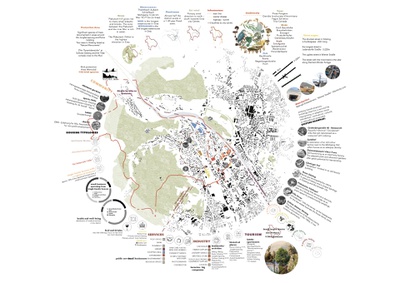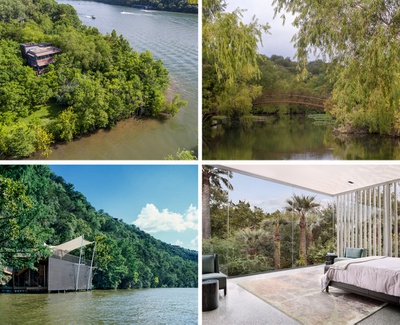EXHIBITION OPENING: 12 JUNE 2024, 6.30 pm || In 2024 we are celebrating the 60th jubilee of the twinning of the cities Graz and Groningen. On this occasion the HDA invited the Dutch/German architecture and urban planning office De Zwarte Hond - which has played a key role in shaping Groningen's urban planning - to present Groningen to the people of Graz. With the exhibition ‘Bold city, brave decisions. How the city of Groningen transformed itself into an exemplary city’, the office provides insights into the transformation of the Dutch city in recent decades and encourages a lively exchange about the challenges the twin cities are facing and the future brave decisions they need to make.
EXHIBITION OPENING: 2 May 2024, 7pm || "SMOTIES - Small and remote places" is a project co-financed by the European Commission as part of the CREATIVE EUROPE CULTURE PROGRAMME. The exhibition shows the results of the four-year collaboration of "Human Cities" for the project. Ten small, remote European locations affected by a strong rural exodus were selected for the project. The selection criterion was their special significance as guardians of material and immaterial culture. The aim is to enhance the remote areas through joint cultural and creative activities with the residents and to develop them into contemporary places worth living in.
Schaufenster-Ausstellung von MIR* im HDA, 6. bis 20. Mai 2024 Lecture Performance von Andrea Scrima 15. Mai 2024 um 19 Uhr im Kunsthaus, Space 04,anschließend LONG NIGHT mit Cocktails im HDA Ausstellungsintervention Loopy Loonies im Foyer des Kunsthauses Graz, 15.05.–19.06.2024
ERÖFFNUNG: 10. APRIL 2024, 19 Uhr || Der größte europäische Ideenwettbewerb für Planer:innen unter 40 Jahren legt in seiner 17. Auflage ein besonderes Augenmerk auf den Aspekt der Fürsorge: Ziel ist es, eine gute Grundlage für alle Lebensformen auf unserem Planeten zu schaffen und die Regenerationsfähigkeit von Lebensräumen zu stärken. Die beiden Jurymitglieder Alessandro delli Ponti und Theresa Krenn sprechen über ihre Arbeiten und Herangehensweise. Dabei treten sie in einen Dialog über die Herausforderungen zukunftsfähige Habitate zu planen. Bernd Vlay, Präsident Europan Austria und HDA-Leiterin Beate Engelhorn begrüßen. Iris Kaltenegger, Generalsekretärin EUROPAN Austria und der slowensiche Architekt und Stadtplaner Blaž Babnik Romaniuk führen durch den Abend.
OPENING 7 FEBRUARY, 2024, 7 pm || The BHP'23 exhibition at the HDA shows 25 nominated and award-winning architectural projects from all over Austria, which were created in particularly intensive collaboration between clients and architects. The Styrian projects will be visited as part of an excursion on 8 March 2024.
On the occasion of the twentieth anniversary of the Kunsthaus in Graz, the Haus der Architektur (HDA) is presenting “Speculations,” an exhibition of drawings and spatial objects by the British architect Peter Cook. Opening with a lecture by Peter Cook: October 22, 2023, 5 pm
Ausstellungseröffnung: 09. November 2023, 18:30 Uhr || Eindrucksvolle Kubaturen, facettenreiche Fassaden oder raffinierte Details – die Werke der „Grazer Schule“ prägen bis heute das Bild der Stadt. Studierende des Instituts für Architekturtheorie, Kunst- und Kulturwissenschaften (akk) der TU Graz widmen sich diesem bedeutenden architektonischen Erbe. Im Frühjahr 2023 wurde im HDA die Ausstellung "Grazer Schule. Stil und Wert eines Phänomens" gezeigt. Nun wandert sie nach Salzburg und wird in der Geschäftsstelle der ZT-Kammer präsentiert.
BHPʼ22—UNDERWAY shows eighteen nominated and award-winning architectural projects from all over Austria, which were created in particularly successful collaborations between clients and architects.
Housing or dwelling is a core human need. The lack of affordable living spaces, especially in metropolitan areas, is currently among the most pressing problems of our time. In addition, there are the challenges of climate change, a new balancing of different forms of mobility, infrastructures, questions related to social coexistence and society. Numerous new building concepts are currently being developed, especially in the field of housing construction, whose strategies can be groundbreaking not only not only for the function of dwelling, but also for the development of cities and regions, as well as for the building industry itself. The exhibition shows selected examples of contemporary architecture that demonstrate viable paths for sustainable building.
Ever since its foundation, Norwegian practice Snøhetta has been proving that architecture can make a significant contribution to the fields of social and ecological sustainability. The wide range of current challenges is reflected in the many buildings and projects developed by Snøhetta that make up its diverse oeuvre. “Changing Conditions” uses individual projects to outline Snøhetta’s approach to design and the story of its development. The selected projects show the diversity in their work, which can be found in urban agglomerations all over the world as well as in the Norwegian and alpine landscape. The exhibition traces the changing framework conditions in the respective period in which the buildings were created. || 24.12.2022-09.01.2023 Exhibition closed
The visual representation of buildings and urban spaces is one of the most important forms of communication in contemporary architecture. In the urban space these visualisations are often used for advertising purposes, decorating scaffolding and construction site fences. The exhibition Veil and Promise investigates the phenomenon of real estate advertising in the public space. Images by photographer Hans Georg Esch of posters from all over the world are juxtaposed with texts by Reinier de Graaf, AMO/OMA, visual analysis by graphic designer Rosa Nussbaum as well as an installation by artist Sven Borger.
The earth's surface is a finite resource, and soil is our most precious commodity. Careless or capital-driven treatment of this resource has massively changed the shape and function of our towns and villages in recent decades. In view of the threat of a climate catastrophe and rising housing prices, the question arises as to whether the current path, with maximum compromises and minimum adaptation, is still sustainable. An extensive and courageous land policy is called for. But where is it?
Seit 1967 verleiht die Zentralvereinigung der ArchitektInnen Österreichs den BauherrInnenpreis, einen der wichtigsten Architekturpreise des Landes. Ausgezeichnet werden BauherrInnen für ihr herausragendes Engagement und das Ermöglichen innovativer und hochwertiger Projekte. In der Ausstellung im HDA sind die sechs ausgezeichneten sowie die nominierten Projekte aus allen Bundesländern zu sehen.
J.MAYER.H is one of the few internationally known contemporary studios successfully working in the areas of architecture, art and design. This exhibition searches for the creative power behind the transdisciplinary work. How do art, design, digital space and architecture influence each other? What shapes the expression of the forms in the space? How do processes of form finding emerge in the interplay of two- and three-dimensionality? For the first time, the HDA is showing an overview of current artistic work in the form of Jürgen Mayer H.’s drawings and collages in dialogue with built projects by the office.
The architect Ferdinand Schuster (1920–1972) is one of the most important figures of post-war Austrian building culture. He realised churches, industrial buildings, leisure and educational facilities as well as housing, primarily in Kapfenberg and Graz. Schuster’s work developed within the context of his reflections on the cultural, social and political dimensions of construction. He passed on this approach during his teaching activities at Graz University of Technology, where he held the chair for architecture and design from 1964 to 1972. 12th September 2020 would have been Ferdinand Schuster’s 100th birthday. The exhibition and publication mark this occasion by providing an insight into his comprehensive oeuvre.
The exhibition Territorial Turn conceived by the Institute of Urbanism, Graz University of Technology, describes the essential change in fundamental framework conditions and values in urbanism in favour of an increased appreciation of public space. The exhibition introduces bold concepts and presents pioneering solutions. Seven selected practical examples from Nantes, Leipzig, Amsterdam, Leuven, Vienna, Péronnes-lez-Antoing and Trofaiach are used to demonstrate a forward-looking approach to urban design.
Miró Rivera Architects have been working for more than 20 years in Austin, Texas/USA. The city is characterized by a topography of gentle hills and the Colorado River. Maintaining the balance and the seemingly effortless, harmonious interplay of architecture and nature is the credo of Miró Rivera Architects. In the exhibition "The Landscape City", the HDA – Haus der Architektur presents selected projects by the firm, showing examples of their approach in three chapters: Trees, Water, and People.
2021 is the year of sports – and not only in Graz, as the Summer Olympic Games have also been scheduled for this year. To mark this occasion, the HDA is showing selected buildings that offer a specific space for movement, catering to the most diverse forms of sporting activity. The spectrum of examples from all over Europe shown in the exhibition presents different planning as well as constructive approaches and also addresses historical and social questions about sport and exercise in everyday urban and rural life. Exhibition opening: July 14th, 7pm
Ausstellung der Primaria1 der SIP (Schule im Pfeifferhof): Eine Schule am Stadtrand von Graz, umgeben von Bäumen. In diesem täglichen Lernumfeld entstand als kreativer Abschluss des Schulprojektes „Messen – Orientieren – Planen“ ein ganzes Dorf mit 20 unterschiedlichsten Traumbaumhäusern. Aus einer Fülle unterschiedlichster gesammelter Recycling-Materialien bastelten die Kinder Modelle, die – zusammen mit Zeichnungen und Texten – im Schaufenster des HDA zu sehen sind.
As we become increasingly aware of the finite nature of material and energy resources and work to address the challenges of climate change, the construction industry, too, is confronted with new issues and responsibilities. The exhibition at the HDA presents studies and practical examples of architectures, conversions and system cycles, demonstrating how high-quality design can emerge from reused materials.
The HDA – House of Architecture presents the exceptional works of Ila Bêka and Louise Lemoine, two of the foremost architectural artists and filmmakers of our time. The exhibition presents a selection of their most famous films. The most recent series is Homo Urbanus, which focuses on the relationship between people and cities in different parts of the world. On display will also be their celebrated films Koolhaas Houselife, Moriyama-San, The Infinite Happiness and Barbicania. This film series on well-known houses emphasises the presence of everyday life within some of the most iconic architectural projects of recent decades.
How can you define sustainable and future-oriented urban development? “NORMAL – direct urbanism x 4”, initiated by transparadiso, focusses on four districts on the outskirts of Graz. The HDA is accompanying the project with an exhibition held as part of Graz Year of Culture 2020. Responding to current social challenges in urban development, transparadiso developed the method of direct urbanism to facilitate socially-engaged urban planning combining direct action and planning. Urban practitioners orizzontale (I), public works (GB) and Georg Winter (D) were invited to work with transparadisoin four Graz districts: Andritz (north), Waltendorf (east), Liebenau (south), and Wetzelsdorf (west). Between spring 2020 and summer 2021, artists and architects will work together with local residents and organisations to realise artistic urban interventions based on transparadiso’s research.
The increasing migration from rural areas to the cities, which results in empty buildings and demographic change in village structures, is a global phenomenon not restricted to Austria or Styria – although the causes behind the development of course differ. The result is a diminishing infrastructure (doctors, schools, shops, public transport), which only speeds up the downward spiral. What possibilities and approaches can be used to slow down or even reverse this negative development? The exhibition shows selected examples of revitalisation in villages and rural municipalities developed with the support of architects, politicians and planners, and reveals different strategies used to successfully reactivate rural spaces.
Nach einer erfolgreichen Schau im Haus der Architektur ist die Ausstellung rund um die Person und das Schaffen Ferdinand Schuster in Kapfenberg zu sehen: Der Architekt Ferdinand Schuster (1920–1972) zählt zu den bedeutendsten Vertretern der österreichischen Baukultur der Nachkriegszeit. Vor allem in Kapfenberg und Graz realisierte er Kirchen-, Industrie-, Freizeit-, Bildungs- und Wohnbauten. Schusters Arbeit entstand stets im Kontext seiner Reflexionen über die kulturellen, sozialen und politischen Dimensionen des Bauens. Am 21. September 2020 wäre Ferdinand Schuster 100 Jahre alt geworden.






















